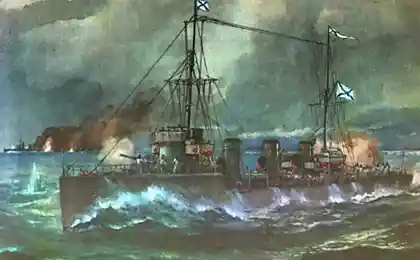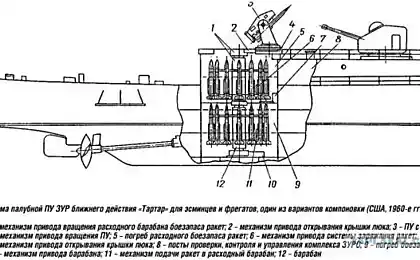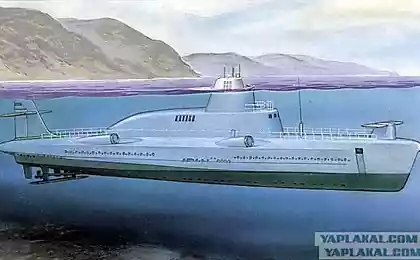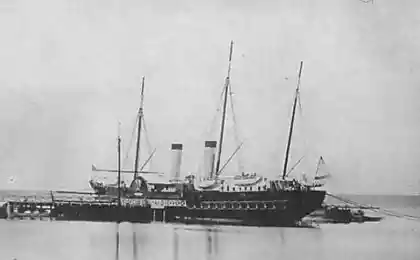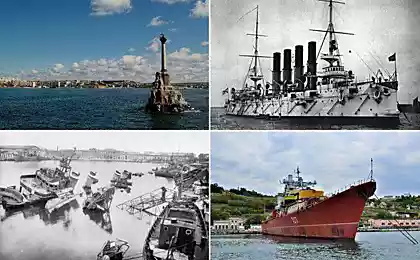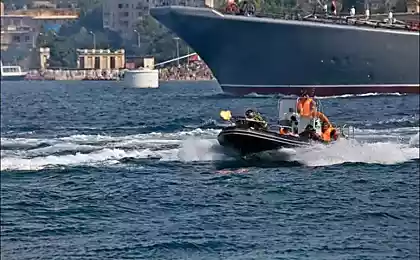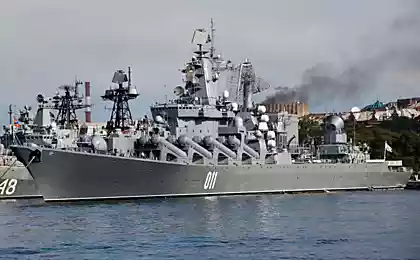1165
The history of the oldest Black Sea Fleet (8 pics + text)
Rescue ship "Volkhov" was laid in 1912 at the shipyard Putilov in St. Petersburg. November 17, 1913 launched on, and July 14, 1915 it was raised by St. Andrew's flag, and the ship was a part of the Baltic Fleet.
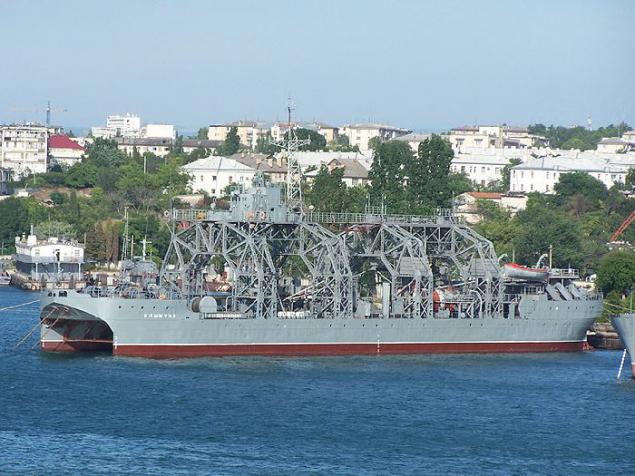
appearance of a rescue vessel was caused by the rapid development of the Russian submarine fleet in the beginning of the XX century, a century which is marked on 19 March 2006 (on this day in 1906 in the official classification of ships of the Russian navy has been included a separate class of ships - submarines). Most accidents and low reliability demanded the creation of the first boats of the ship, which took on board the means of lifting the emergency submarine.
The project is the first in the country's history of specialized double-hulled vessel - lifeguard submarine was developed in 1911 by order of the Naval General Staff. As the prototype used a German catamaran rescue "Volcano».
Project Putilov was the best of the submitted. As a result, the plant received December 30, 1911 order number 3559 Department of General Affairs of the GAM (the Main Directorate of shipbuilding). The order was passed to the execution of 25 January 1912. The contract for the construction of the vessel was signed with the Company Putilov plants (director of the shipyard - NN Kuteinikov) May 5, 1912. Adoption of the "general drawings" on 4 October, and for 12 November, under the supervision of Colonel Corps of Naval Architects NV Lesnikova (later he was replaced by Colonel AP Shershov) began assembling the hull on the stocks.
The original draft of Colonel Shershova can effectively solve such problems. Rescuer "Volkhov" was built as a double-hulled vessel catamaran, had four 18-meter lifting the farm, designed to lift the submarine, as well as the necessary equipment for the repair of ships and diving. Displacement of the ship is 2,400 tons, 1,000 tons of load capacity, speed of 10 knots. Four pairs of guineas, which was equipped with a "Volkhov", greatly facilitates the ship salvage compared with pontoons, massively applied in the time. In addition, the ship provided a fairly comfortable life for the team. Built under the supervision of Alexander Pavlovich Shershova, he was at the time one of the most advanced and sophisticated salvage vessels in the world. "Volkhov" actively participated in the First World War.
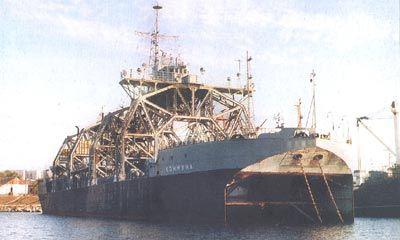
It is worth noting that the manufacture of the hull, a special viscous malleable steel ship, the secret of which is now lost. State body "Commune" made from Putilov steel, and to this day remains an almost perfect - rust and turn to dust iron constructions installed on a catamaran in the later time period.
The vessel "Volkhov" (the original name of "Commune") was incorporated 12.11.1912, in St. Petersburg, at the Putilov factory, launched on 11.17.1913 and 07.14.1915, the city entered into service of the Baltic fleet, including the lists classed fleet transports.
Routine tests only began March 1, 1915. The first commander of "Volkhov" was Captain 2nd Rank Aleksandr Antonovich Jakubowski. Acceptance Act was signed July 1, 1915, and already on July 14, the vessel was first raised naval flag. "Volkhov" officially entered the campaign, joining the submarine division of the Baltic fleet as a floating base.
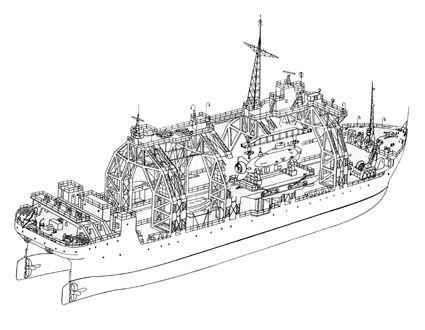
Alas, in 1917, "Volkhov" and his team have done the same evolution that most of the ships of the Baltic Sea - are increasingly falling under the influence of the revolutionary elements. In Helsingfors, where the "Volkhov", in July 1917, on a number of ships have been attempts to lower the flag of St. Andrew, but instead raise the banner of bloody revolution. And on the battleship "Petropavlovsk" - even a black banner with the words "Death to the bourgeois meters!". Under the influence of these events is less and less left on ships personnel personnel - went disagree with "Bolshevisation" fleet.
In April 1918, "Volkhov" in the squadron of the Baltic Fleet made the transition from Helsingfors to Kronstadt. It was the famous Ice campaign, which has participated and which led officers, headed by the commander of the Baltic Fleet, Captain 1st Rank AM Shchastny (later he was shot on the personal instructions of Trotsky), does not want the ships of the Baltic fleet fell into the hands of the Germans. Some ships of the Baltic Fleet were still going on this trip and a St. Andrew's, and under the tricolor Russian flag. It was, perhaps, the last page of the biography of the ship related to the pre-Soviet period. Unfortunately, the team "Volkhov" (as opposed to the teams icebreakers "Volynets", "Tarmo" and "Black Sea number 1" gone to Reval) did not find a sufficient number of determined opponents of Bolshevism, which could, taking advantage of the campaign to ensure passage of the ship on the side of the Whites. In Kronstadt he finally fell under the control of the Bolsheviks. During the Civil War, and stayed here a ship, and its crew, which consisted of qualified divers and repairers, engaged in ship repair, including the Volga, Volga Flotilla serving red during the fighting of 1918-1919. Unfortunately, there has not been studied as a "Volkhov" in the Kronstadt uprising in March 1921, but it can be assumed that his team did not remain aloof from the anti-Bolshevik movement that swept almost all the ships and military units based in Kronstadt.
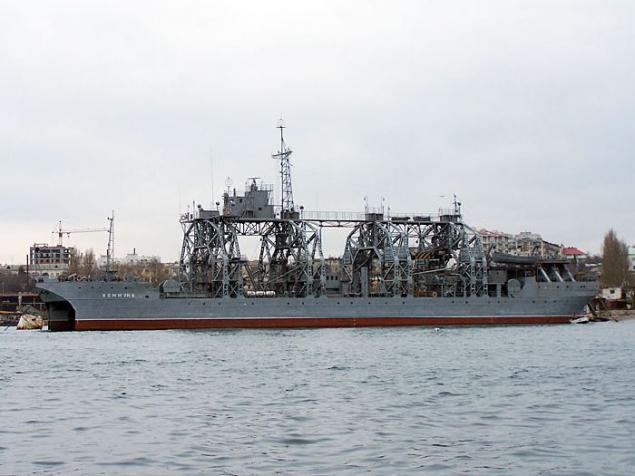
After that, the history of the ship as "Volkhov", did not last long - December 31, 1922 the ship was renamed the "Commune". The subsequent history has already "Commune", for many years was associated with the Soviet Navy.
In the period between the wars international fame "Commune" has received in connection with the rise in August 1928 British submarine «L -55», sunk on June 4, 1919 in Kaporskaya Bay Gulf of Finland. (Most likely, she was sunk by artillery fire destroyers "Azard" and "Gabriel"). Despite the fact that the lifting weight «L -55» was about 860 tons, and it is strongly "cling" to the ground, "Commune" brilliantly coped with the task of lifting the boat to the surface and deliver it to Kronstadt. Discovered on board the submarine, the remains of 42 British sailors and officers were at the request of the British government transferred on board arrived in Kronstadt British steamer "Truro" that took them to Portsmouth for burial.
In 1933, "Commune" as successfully implemented the rise of number 9 of the submarine type "Bars" from the depth of 84 meters, which in those days was very easy, because its divers had no experience at such depths. Subsequently, was found and raised by the "communes" another submarine type "Bars» - № 3.
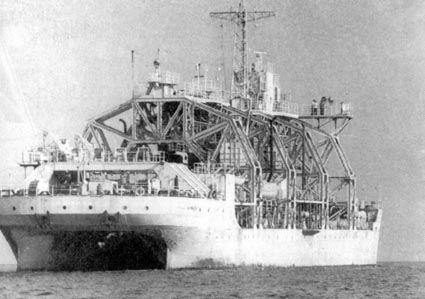
In 1941-1945 the ship was in Kronstadt and Leningrad, carrying out repair of submarines and ships. According to Colonel EE Leibowitz, during the blockade of the crew performed more than 60 rescue, raised 11 sunken vessels, made diving operations on the damaged aircraft German battleship "October Revolution". The crew, especially divers, brought to work on the so-called lifting "Road of Life" on Lake Ladoga and recovery vessels on the Volga at Stalingrad. In the postwar period, "municipality" has done a great job of lifting vessels in the Baltic Sea.
In 1967 began a new period in the life of the ship - from the Baltic Sea, he was transferred to the Black Sea. Survey vessel, designed by military shipbuilders Imperial Navy and built by masters Putilov, showed his good technical condition and high quality design. The hull is made of forged Putilov steel for years of service had deteriorated slightly, riveted joints 200-ton ship-raising farms were in good condition.

In the years 1970-1973 "Commune" was held on retrofitting SMZ as a modern medium of deep submersibles. In December 1975, deep-water apparatus, which provides a "Commune", sank to a depth meter 2026.
In the years 1979-1984, at the same SMZ, produced yet another additional equipment, expand the range of problems to solve which the ship could be involved - the ship has been found a device that allows the body to lower skilled submarines up to 2000 meters. In addition, the main engines were replaced.
In 1991, after the collapse of the Soviet Union, for the "Commune", as for the whole of the Black Sea Fleet, began a long period of uncertainty. It was at this time in the first half of the 90s, when there was massive destruction of the Black Sea Fleet by thoughtless cancellation and sale of scrap metal a huge number of ships, the former "Volkhov" experienced perhaps the greatest danger for years of service.
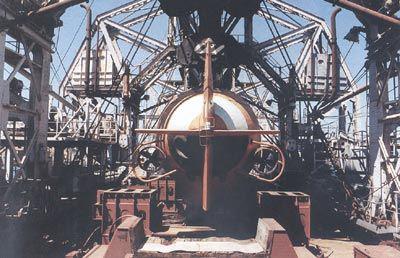
But the "Volkhov" lucky - he did not hunted for scrap in uniform. And in 1997, 80 years later, the long-awaited moment of the ship again hoisted the flag of St. Andrew. It happened on June 12 on the day of the declaration of the sovereignty of Russia. But, unfortunately, the ship has not been returned to its historical name. Until now, he has a ridiculous name.
At present, the rescue ship "commune" is the oldest ship of the Russian Navy (in 2008 - 93, in the ranks).


appearance of a rescue vessel was caused by the rapid development of the Russian submarine fleet in the beginning of the XX century, a century which is marked on 19 March 2006 (on this day in 1906 in the official classification of ships of the Russian navy has been included a separate class of ships - submarines). Most accidents and low reliability demanded the creation of the first boats of the ship, which took on board the means of lifting the emergency submarine.
The project is the first in the country's history of specialized double-hulled vessel - lifeguard submarine was developed in 1911 by order of the Naval General Staff. As the prototype used a German catamaran rescue "Volcano».
Project Putilov was the best of the submitted. As a result, the plant received December 30, 1911 order number 3559 Department of General Affairs of the GAM (the Main Directorate of shipbuilding). The order was passed to the execution of 25 January 1912. The contract for the construction of the vessel was signed with the Company Putilov plants (director of the shipyard - NN Kuteinikov) May 5, 1912. Adoption of the "general drawings" on 4 October, and for 12 November, under the supervision of Colonel Corps of Naval Architects NV Lesnikova (later he was replaced by Colonel AP Shershov) began assembling the hull on the stocks.
The original draft of Colonel Shershova can effectively solve such problems. Rescuer "Volkhov" was built as a double-hulled vessel catamaran, had four 18-meter lifting the farm, designed to lift the submarine, as well as the necessary equipment for the repair of ships and diving. Displacement of the ship is 2,400 tons, 1,000 tons of load capacity, speed of 10 knots. Four pairs of guineas, which was equipped with a "Volkhov", greatly facilitates the ship salvage compared with pontoons, massively applied in the time. In addition, the ship provided a fairly comfortable life for the team. Built under the supervision of Alexander Pavlovich Shershova, he was at the time one of the most advanced and sophisticated salvage vessels in the world. "Volkhov" actively participated in the First World War.

It is worth noting that the manufacture of the hull, a special viscous malleable steel ship, the secret of which is now lost. State body "Commune" made from Putilov steel, and to this day remains an almost perfect - rust and turn to dust iron constructions installed on a catamaran in the later time period.
The vessel "Volkhov" (the original name of "Commune") was incorporated 12.11.1912, in St. Petersburg, at the Putilov factory, launched on 11.17.1913 and 07.14.1915, the city entered into service of the Baltic fleet, including the lists classed fleet transports.
Routine tests only began March 1, 1915. The first commander of "Volkhov" was Captain 2nd Rank Aleksandr Antonovich Jakubowski. Acceptance Act was signed July 1, 1915, and already on July 14, the vessel was first raised naval flag. "Volkhov" officially entered the campaign, joining the submarine division of the Baltic fleet as a floating base.

Alas, in 1917, "Volkhov" and his team have done the same evolution that most of the ships of the Baltic Sea - are increasingly falling under the influence of the revolutionary elements. In Helsingfors, where the "Volkhov", in July 1917, on a number of ships have been attempts to lower the flag of St. Andrew, but instead raise the banner of bloody revolution. And on the battleship "Petropavlovsk" - even a black banner with the words "Death to the bourgeois meters!". Under the influence of these events is less and less left on ships personnel personnel - went disagree with "Bolshevisation" fleet.
In April 1918, "Volkhov" in the squadron of the Baltic Fleet made the transition from Helsingfors to Kronstadt. It was the famous Ice campaign, which has participated and which led officers, headed by the commander of the Baltic Fleet, Captain 1st Rank AM Shchastny (later he was shot on the personal instructions of Trotsky), does not want the ships of the Baltic fleet fell into the hands of the Germans. Some ships of the Baltic Fleet were still going on this trip and a St. Andrew's, and under the tricolor Russian flag. It was, perhaps, the last page of the biography of the ship related to the pre-Soviet period. Unfortunately, the team "Volkhov" (as opposed to the teams icebreakers "Volynets", "Tarmo" and "Black Sea number 1" gone to Reval) did not find a sufficient number of determined opponents of Bolshevism, which could, taking advantage of the campaign to ensure passage of the ship on the side of the Whites. In Kronstadt he finally fell under the control of the Bolsheviks. During the Civil War, and stayed here a ship, and its crew, which consisted of qualified divers and repairers, engaged in ship repair, including the Volga, Volga Flotilla serving red during the fighting of 1918-1919. Unfortunately, there has not been studied as a "Volkhov" in the Kronstadt uprising in March 1921, but it can be assumed that his team did not remain aloof from the anti-Bolshevik movement that swept almost all the ships and military units based in Kronstadt.

After that, the history of the ship as "Volkhov", did not last long - December 31, 1922 the ship was renamed the "Commune". The subsequent history has already "Commune", for many years was associated with the Soviet Navy.
In the period between the wars international fame "Commune" has received in connection with the rise in August 1928 British submarine «L -55», sunk on June 4, 1919 in Kaporskaya Bay Gulf of Finland. (Most likely, she was sunk by artillery fire destroyers "Azard" and "Gabriel"). Despite the fact that the lifting weight «L -55» was about 860 tons, and it is strongly "cling" to the ground, "Commune" brilliantly coped with the task of lifting the boat to the surface and deliver it to Kronstadt. Discovered on board the submarine, the remains of 42 British sailors and officers were at the request of the British government transferred on board arrived in Kronstadt British steamer "Truro" that took them to Portsmouth for burial.
In 1933, "Commune" as successfully implemented the rise of number 9 of the submarine type "Bars" from the depth of 84 meters, which in those days was very easy, because its divers had no experience at such depths. Subsequently, was found and raised by the "communes" another submarine type "Bars» - № 3.

In 1941-1945 the ship was in Kronstadt and Leningrad, carrying out repair of submarines and ships. According to Colonel EE Leibowitz, during the blockade of the crew performed more than 60 rescue, raised 11 sunken vessels, made diving operations on the damaged aircraft German battleship "October Revolution". The crew, especially divers, brought to work on the so-called lifting "Road of Life" on Lake Ladoga and recovery vessels on the Volga at Stalingrad. In the postwar period, "municipality" has done a great job of lifting vessels in the Baltic Sea.
In 1967 began a new period in the life of the ship - from the Baltic Sea, he was transferred to the Black Sea. Survey vessel, designed by military shipbuilders Imperial Navy and built by masters Putilov, showed his good technical condition and high quality design. The hull is made of forged Putilov steel for years of service had deteriorated slightly, riveted joints 200-ton ship-raising farms were in good condition.

In the years 1970-1973 "Commune" was held on retrofitting SMZ as a modern medium of deep submersibles. In December 1975, deep-water apparatus, which provides a "Commune", sank to a depth meter 2026.
In the years 1979-1984, at the same SMZ, produced yet another additional equipment, expand the range of problems to solve which the ship could be involved - the ship has been found a device that allows the body to lower skilled submarines up to 2000 meters. In addition, the main engines were replaced.
In 1991, after the collapse of the Soviet Union, for the "Commune", as for the whole of the Black Sea Fleet, began a long period of uncertainty. It was at this time in the first half of the 90s, when there was massive destruction of the Black Sea Fleet by thoughtless cancellation and sale of scrap metal a huge number of ships, the former "Volkhov" experienced perhaps the greatest danger for years of service.

But the "Volkhov" lucky - he did not hunted for scrap in uniform. And in 1997, 80 years later, the long-awaited moment of the ship again hoisted the flag of St. Andrew. It happened on June 12 on the day of the declaration of the sovereignty of Russia. But, unfortunately, the ship has not been returned to its historical name. Until now, he has a ridiculous name.
At present, the rescue ship "commune" is the oldest ship of the Russian Navy (in 2008 - 93, in the ranks).







